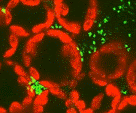Plant Pathology, Department of

Department of Plant Pathology: Faculty Publications
Document Type
Article
Date of this Version
June 1993
Abstract
The polymerase chain reaction (PCR) provides a simple, ingenious method to exponentially amplify specific DNA sequences by in vitro DNA synthesis. Three essential steps to PCR (Figure 1) include (a) melting of the target (b) annealing of two oligonucleotide primers to the denatured DNA strands, and (c) primer extension by a thermostable DNA polymerase (123). Newly synthesized DNA strands serve as targets for subsequent DNA synthesis as the three steps are repeated up to 50 times. The specificity of the method derives from the synthetic oligonucleotide primers, which base-pair to and define each end of the target sequence to be amplified. The use of PCR grew rapidly in plant pathology, as in other disciplines, with the introduction in 1988 of Thermus aquaticus (Taq) DNA polymerase. This enzyme exhibits relative stability at DNA-meltintgem peratures, which eliminates the need for enzyme replenishment after each cycle of synthesis, reduces PCR costs and allows automated thermal cycling. PCR offers several advantages compared to more traditional methods of diagnosis: organisms need not be cultured prior to their detection by PCR; the technique possesses exquisite sensitivity, with the theoretical potential to detect a single target molecule in a complex mixture without using radioactive probes; and it is rapid and versatile. Similar to serology, both narrow and broad selectivities are possible and, depending on the choice of primers, the method facilitates the detection of a single pathogen or many members of a group of related pathogens. Unlike serology, the development of reagents with narrow or broad specificities is accomplished almost at will with lower cost. Synthesis of hundreds of different PCR primers generates costs comparable to those of developing only a few monoclonal antibodies. Molecular genetic protocols in a variety of other disciplines employ PCR. Several reviews on its use and methodology in fields other than plant pathology have been published recently (4, 10, I1, 46, 46a, 91, 137). This review therefore focuses on the use of PCR for diagnosis of plant diseases and other applications in plant pathology.


Comments
Published in Annu. Rev. Phytopathol. 1993.31:81-109.